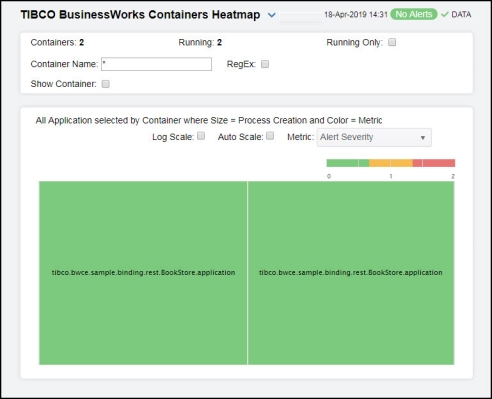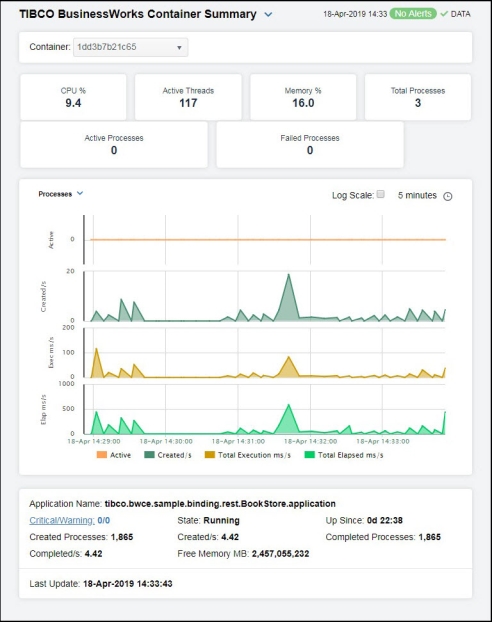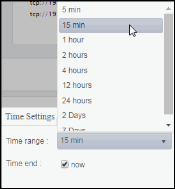BW Containers
These displays present process performance data for your BusinessWorks containers across BusinessWorks Domains. Use these displays to monitor critical alerts for all your BusinessWorks containers, and investigate those alerts in lower-level displays. Clicking BW Containers from the left/navigation menu opens the TIBCO BusinessWorks Containers Table display, which shows a tabular view of all available container performance data. The options available under BW Containers are:
| • | BW Containers Heatmap: Opens the TIBCO BusinessWorks Containers Heatmap , which is a color-coded heatmap view of selected container performance metrics. |
| • | BW Container Summary: Opens the TIBCO BusinessWorks Container Summary display, which shows current and historical metrics for a single container. |
TIBCO BusinessWorks Containers Table
This display provides a view of the most critical BusinessWorks container alert states pertaining to process creation and execution for all nodes on which the containers are deployed in a tabular format. Use this display to quickly identify containers with critical alerts.
Each row in the table is a container in the selected domain. Check performance and utilization metrics for processes (for example, Active Processes, Active/s, Created Processes, Completed Processes, Suspended Processes), execution rates (for example, Rate Exec Time ms/s), memory and CPU utilization (for example, Used Memory and Used CPU%) as well as many others.
By default, all containers are listed in the table, but you can enter a string in the Application Name filter field to limit the list of containers shown in the display. Click a column header to sort column data in numerical or alphabetical order. Click the Running Only check box to only view containers that are up and running in the table.
To view additional details for a specific container, drill-down and investigate by clicking the row in the table for the desired container, which opens the TIBCO BusinessWorks Container Summary display.

|
Fields and Data: |
||||
|
|
Containers: |
The total number of containers listed in the table. |
||
|
|
Running |
The total number of containers that are currently running. |
||
|
|
Running Only |
Select to show only running containers in the table. |
||
|
|
Domain: |
Choose a domain to show data for in the display. |
||
|
|
Application Name |
Enter a string (all or part of a container name) to filter the data shown in the display. If you enter part of an container name, you must enter “*” before and/or after the string. For example, if you have a container named ContNameOne, you could filter using *Name*, *NameOne, or ContName*. |
||
|
|
RegEx |
Toggles the Application Name filter to accept Regular Expressions for filtering. For example, if your application name is ContNameOne and this option was toggled on, you could enter “Name” (without using “*”to display the container in the table). |
||
|
Table: |
||||
|
|
Application Name |
The name of the application. |
||
|
|
Alert Level |
The most critical alert state for alerts in the row:
|
||
|
|
Alert Count |
The total number of active alerts in the container. |
||
|
|
State |
The current status of the application. Valid values are Running and Stopped. |
||
|
|
Container ID |
The ID of the container. |
||
|
|
Active Processes |
The number of currently active processes in the container. |
||
|
|
Active/s |
The rate of processes becoming active. |
||
|
|
Created Processes |
The number of processes that have been created since the last data update. |
||
|
|
Created/s |
The number of processes created per second in the container. |
||
|
|
Completed Processes |
The number of completed processes in the container. |
||
|
|
Completed/s |
The rate of processes being completed. |
||
|
|
Most Recent Exec Time ms |
The number of seconds for the most recently executed process. |
||
|
|
Rate Exec Time ms/s |
The rate of processes executed in the container, in milliseconds per second. |
||
|
|
Suspended Processes |
The number of suspended application processes in the container. |
||
|
|
Failed Processes |
The number of failed processes in the container. |
||
|
|
Version |
The version of the container. |
||
|
|
Module |
The name of the container module. |
||
|
|
Shared Module |
The name of the shared module, if any. |
||
|
|
Time Stamp |
The date and time the row data was last updated. |
||
TIBCO BusinessWorks Containers Heatmap
Clicking BW Containers Heatmap in the left/navigation menu opens the TIBCO BusinessWorks Container Heatmap, which allows you to view the most critical BusinessWorks container alert states pertaining to process creation and execution for all nodes on which the containers are deployed. Use this display to quickly identify containers with critical alerts.
Each rectangle in the heatmap represents a container. The rectangle color indicates the most critical alert state associated with the container. The rectangle size represents process creation across containers; a larger size is a larger value.
By default, all containers are listed in the heatmap, and is based on the Alert Severity metric. You can select a different metric from the Metric drop-down menu to view the heatmap based on a different metric. To view data shown for a specific container(s) in the display, enter a string in the Container Name filter field. Use the Container Names check-box  to include or exclude labels in the heatmap. You can mouse over a rectangle to see additional metrics. Toggle between the commonly accessed Table and Heatmap displays by clicking the drop down list on the display title.
to include or exclude labels in the heatmap. You can mouse over a rectangle to see additional metrics. Toggle between the commonly accessed Table and Heatmap displays by clicking the drop down list on the display title.
Drill-down and investigate details for a specific container by clicking a rectangle in the heatmap, which opens the details for the selected container in the TIBCO BusinessWorks Container Summary display.

|
Filter By: The display might include these filtering options: |
||||
|
|
Containers: |
The total number of containers currently shown in the heatmap. |
||
|
|
Running |
The total number of containers currently running. |
||
|
|
Running Only |
Select to show only running containers in the heatmap. |
||
|
|
Container Name |
Enter a string (all or part of a container name) to filter the data shown in the display. If you enter part of a container name, you must enter “*” before and/or after the string. For example, if you have an container named ContNameOne, you could filter using *Name*, *NameOne, or ContName*. You can also enable the RegEx toggle to just enter a portion of the container name. |
||
|
|
RegEx |
Toggles the Container Name filter to accept Regular Expressions for filtering. For example, if your container name is ContNameOne and this option was toggled on, you could enter “Name” (without using “*”to display the container in the heatmap). |
||
|
|
Show Container |
Check to include container name labels in the heatmap. |
||
|
Fields and Data: |
||||
|
|
Log Scale |
Select to enable a logarithmic scale. Use Log Scale to see usage correlations for data with a wide range of values. For example, if a minority of your data is on a scale of tens, and a majority of your data is on a scale of thousands, the minority of your data is typically not visible in non-log scale graphs. Log Scale makes data on both scales visible by applying logarithmic values rather than actual values to the data. |
||
|
|
Auto Scale |
Select to enable auto-scaling. When auto-scaling is activated, the color gradient bar's maximum range displays the highest value. NOTE: Some metrics auto-scale automatically, even when Auto is not selected. |
||
|
|
Metric |
Select the metric driving the heatmap display. The default is Alert Severity. Each Metric has a color gradient bar that maps values to colors. The heatmap consists of multiple rectangles, where each rectangle represents a container. Mouse-over any rectangle to display the current values of the metrics for the container. Click on a rectangle to drill-down to the associated TIBCO BusinessWorks Container Summary display for a detailed view of metrics for that particular container. |
||
|
|
|
Alert Severity |
The maximum level of alerts in the heatmap rectangle. Values range from 0 - 2, as indicated in the color gradient
|
|
|
|
|
Alert Count |
The total number of critical and warning alerts in the heatmap rectangle. The color gradient |
|
|
|
|
Active |
The total number of active processes in the heatmap rectangle. The color gradient |
|
|
|
|
Completed |
The total number of completed processes in the heatmap rectangle. The color gradient |
|
|
|
|
Suspended |
The total number of suspended processes in the heatmap rectangle. The color gradient |
|
|
|
|
Failed |
The total number of failed processes in the heatmap rectangle. The color gradient |
|
|
|
|
Created/s |
The number of processes created per second in the heatmap rectangle. The color gradient |
|
|
|
|
Suspended/s |
The number of suspended processes per second in the heatmap rectangle. The color gradient |
|
|
|
|
Failed/s |
The number of failed processes per second in the heatmap rectangle. The color gradient |
|
|
|
|
Exec Time/s |
The process execution time per second in the heatmap rectangle. The color gradient |
|
|
|
|
Most Recent Exec Time |
The execution time for the most recently executed process in the heatmap rectangle. The color gradient |
|
|
|
|
Avg Exec Time |
The average execution time for all processes in the heatmap rectangle, calculated by dividing the delta execution time for the interval by the delta completed, or the number of process instances that completed in the interval. The color gradient |
|
|
|
|
Avg Elapsed Time |
The average elapsed time for all processes in the heatmap rectangle, calculated by dividing the delta elapsed time for the interval by the delta completed, or the number of process instances that completed in the interval. The color gradient |
|
TIBCO BusinessWorks Container Summary
Clicking BW Container Summary in the left/navigation menu opens the TIBCO BusinessWorks Container Summary display, which allows you to track utilization and performance metrics for specific BW containers. Clicking on the information boxes at the top of the display takes you to the TIBCO BusinessWorks Containers Table display, where you can view additional container data.
You can toggle between a Processes trend graph and a Resources trend graph. The Processes trend graph shows the number of active containers, the container created rate, the total execution rate, and the total elapsed rate over a selected time range. The Resources trend graph shows CPU% utilization, current number of Threads, Memory% utilization and Bytes used over a selected time range.
Clicking the Critical/Warning link at the bottom of the display opens the Alerts Table by Component display.

|
Filter By: The display might include these filtering options: |
||||
|
|
Container |
Choose the container for which you want to view data in the display. |
||
|
Fields and Data: |
||||
|
|
CPU % |
The percentage of CPU used by the AppNode. |
||
|
|
Active Threads |
The total number of active threads on the AppNode. |
||
|
|
Memory % |
The percentage of memory used by the AppNode. |
||
|
|
Total Processes |
The total number of processes on the container. |
||
|
|
Active Processes |
The total number of active processes on the AppNode. |
||
|
|
Failed Processes |
The total number of failed processes on the AppNode. |
||
|
|
Processes Trend Graph
|
Traces the sum of process metrics across all processes in all slices of the selected container. Active -- Traces the number of currently active application processes on the container. Created/s -- Traces the number of created application processes on the container. Total Execution ms/s -- Traces the rate at which the application is accumulating process execution time, in milliseconds per second, on the container. Total Elapsed ms/s -- Traces the rate at which the application accumulates process elapsed time, in milliseconds per second, on the container. |
||
|
|
|
Log Scale |
Select to enable a logarithmic scale. Use Log Scale to see usage correlations for data with a wide range of values. For example, if a minority of your data is on a scale of tens, and a majority of your data is on a scale of thousands, the minority of your data is typically not visible in non-log scale graphs. Log Scale makes data on both scales visible by applying logarithmic values rather than actual values to the data. |
|
|
|
|
Time Settings |
Select a time range from the drop down menu varying from 5 Minutes to Last 7 Days. By default, the time range end point is the current time.
To change the time range, deselect the now toggle, which displays some additional date fields. You can click the left and right arrow buttons to decrease the end time by one time period (the time selected in the Time range drop down) per click, or you can choose the date and time from the associated calendar and clock icons. You can also enter the date and time in the text field using the following format: MMM dd, YYYY HH:MM:ss. For example, Aug 21, 2018 12:24 PM. Click the now toggle to reset the time range end point to the current time.
|
|
|
|
Name |
The name of the application. |
||
|
|
Up Since |
The length of time that the application has been up and running. |
||
|
|
Completed Processes |
The number of completed processes. |
||
|
|
Critical/Warning |
The number of critical and warning alerts. |
||
|
|
Created Processes |
The number of created processes. |
||
|
|
Completed/s |
The rate of completed processes. |
||
|
|
State |
The current status of the application. Valid values are Running and Stopped. |
||
|
|
Created/s |
The rate at which processes are being created. |
||
|
|
Free Memory MB |
The amount of free memory, in megabytes. |
||
|
|
Last Update |
The date and time of the last data update. |
||



















